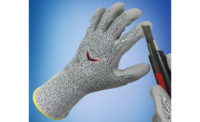IGA Helping Hand
Glove ratings should reflect real-world risks

A quick review of old and new test standards for safety gloves will help you find the answers. For cut, puncture and abrasion, the American National Standards Institute (ANSI) uses ASTM and EN338 test methods to measure glove performance, and there are several dexterity standards.
For cut, the test arena is fairly straightforward — ANSI uses a sharp metal blade which moves across the glove material until it cuts through; if the glove scores less than 200 grams, it gets a 0 and if it goes over 3500 grams, it gets the highest Level 5.
For puncture, picking the right test is a little harder. There are three basic puncture tests with very different size probes: a very large nail, a small nail, and the smallest is a hypodermic needle. You need to pick the test that best reflects your safety requirement.
ANSI puncture test has the largest penetrator, the EN338 5mm probe, which is about the size of a pencil, making it perfect to show the protection from large nails but irrelevant to needles. ANSI puncture highest rating, Level 5, is achieved at 150 Newtons or over 15,000 grams force, with Level 2 starting at 20N or >2000 grams force.
On the opposite end, needle and fine penetrator threats are tested against the new ASTM standard, ASTM F2878-10, using a 28-gauge hypodermic needle to measure puncture resistance; however, many companies continue to report only ANSI’s large penetrator puncture values.
Smack in the middle is ASTM F 1342, adopted by the National Institute of Justice (NIJ), which uses a 2mm probe that looks like a small nail. NIJ gives a LOW rating for a glove with values between 20 N to 59 N (2000 to 6000 grams force), the next level MODERATE if under 99 N (~1000 grams force) is achieved, and the HIGH is for over 100 N to 150 N (1500 grams force) or higher.
For abrasion, ANSI uses ASTM D3389 or the Taber test, which counts the number of cycles it takes an abrasive surface to wear through the glove material — the highest level is Level 6 with over 20,000 revolutions of wear on the glove material, while a glove passing Level 1 of this test must only make it through at least 100 cycles.
You should note that Level 0 to Level 3 have a lighter load of under 500g load on the abrasive test, while the highest levels of 4 to 6 have a load that is double that at 1000g to make the test harder.
For dexterity, there are three standardized tests available.
The first is the pin test, where the subject wears a glove to pick up five pins that are equal in length but vary in diameters from 11 mm to 5 mm, the smallest being slightly thinner than an average pencil. This pin test has been adopted by NIJ, ANSI and European Certification EN420. While gloves that allow the smallest pin to be picked up will achieve the highest rating, some gloves have a surface with just enough tack to pick up the smaller pins, even though the gloves may offer very little true dexterity.
A second dexterity measure is the Minnesota Manual Dexterity Test, which involves the rapid placement of 60 individual discs in a series of prescribed test patterns. After establishing a baseline bare-hand result, a tester then performs the prescribed movements again while wearing gloves. A glove that preserves 85 percent of bare-hand dexterity is said to offer better comfort than a glove that preserves only 75 percent.
A third test, based on ASTM D4032-08 circular bend test, evaluates a material’s stiffness and thickness to measure dexterity. The palm section of a glove is used as a sample to test glove-bending stiffness using a constant rate compression-testing machine. The glove sample is placed over a 1-inch opening with a plunger mounted on the testing machine’s crosshead. The max load over the plunger is recorded as it is being pushed through the glove sample. Obviously the less force it takes to press the glove materials through the opening, the more supple and therefore higher dexterity.
Does the ability to touch and feel outweigh everything else?
Engineers of protective fabrics try to strike the perfect balance between cut, puncture and dexterity in safety gloves to protect the end user from hand injuries. Uninformed buyers, on the other hand, drive the market by demanding high rated gloves no matter what, and end users in turn demand safety gloves to minimize risks involved in performing their daily tasks, but not at the expense of flexibility, tactile sensitivity and ease of use. Simply put, cut and puncture need to make room for dexterity.
Many buyers of safety gloves fail to consider that standardized tests against which a high-rated glove has been evaluated might have nothing to do with the threats of real-world applications. They disregard the significant impact of the wrong glove on comfort and productivity. A mismatched glove and application can even result in repetitive strain injuries, swapping one type of injury for another.
In many industrial settings, from operating machinery to handling sharp, pointy objects, injuries and accidents are prone to happen due to the very nature of how diligently laborers have to work with their hands and fingers. Therefore, safety gloves are often used throughout the day to prevent accidental cuts and punctures on the job. But is it really just a matter of purchasing the highest cut rated glove on the market and call it a day? The answer is: no.
Manufacturers, noting buyers’ preference for higher ratings, are motivated to achieve such ratings at any cost and are inclined to market and sell based on little else. Manufacturers and the glove end user must work together to conduct honest and detailed analyses of identified risks, worker comfort and the product’s ability to address each protective performance category but include dexterity.
Looking for a reprint of this article?
From high-res PDFs to custom plaques, order your copy today!





.jpg?t=1721257160)

